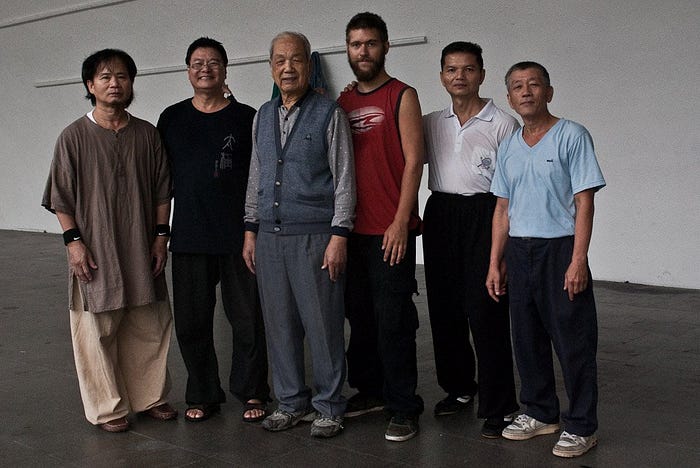Taiji and Qigong
I started practicing taiji (and the related practices of qigong and standing meditation) in 2006 and have done it on an (almost) daily basis since then. I don’t remember what initially attracted me to taiji, but I remember feeling that this was something I wanted to dedicate myself to from the beginning.
In this article I try to introduce taiji, qigong and standing meditation while giving a personal account of my experiences with practicing and learning. Many books have been written on the philosophy and practice of taiji and this article is should not be seen as any kind of “truth” about what taiji is or how to practice it. It should rather be seen as a reflection of my current level of understanding.

What is taiji
Taijiquan, most often shortened to tai chi or taiji as I do here, is a Chinese internal martial art, meditation system and health practice. There are multiple schools of taiji (the most well-known are the chen, yang, wu and sun traditions) with their own lineages and there are multiple training systems within these schools. Taiji is often practiced in combination with qigong and standing meditation and most systems have a load of different solo exercises, partner exercises and moving forms (what most people think is taiji).
Taiji as a practice points to principles of being and moving that are rooted in Taoist philosophy. For me the core principle is Wuwei, which means something like “effortless action”. The principle points to how practitioners of taiji attempts to move (and fight for those who practice the martial aspects) with as little effort as possible.
When practicing taiji we emphasize sensitivity. We practice becoming more sensitive to how we are balanced and towards the tensions in our bodies. This is also an exercise of “awareness in action” becoming better at being present in our own body-beings. When we do partner work we also practice becoming sensitive towards their balance, tensions and intentions. Honing this relaxed and sensitive state allows a skilled practitioner of taiji to respond to what is coming towards them (yielding and neutralizing), rather than reacting to it (blocking and fighting). This is true at the martial level as well as in everyday life.
A core principle of taiji is never to meet force with force (fight responses). Instead, you yield to what is coming towards you by allowing its energy to move in the direction it wants to. Yielding is a “moving with” that happens as a harmonious response to an external pressure. It does not mean fleeing, collapsing, or retreating (flight responses) but rather staying within your own integrity while responding to a force from the outside.
Being able to yield requires us to be soft and firm at the same time and practitioners of taiji will often use references to Yin/Yang to communicate the way in which you are meant to embody structure/frame and softness at the same time.
Embodying the principles of taiji is a long journey. For myself I have found that taiji (at least after the initial years of learning the forms) is more a practice of unlearning than learning. It is about letting go of embodied patterns of tension and movement and fixed ideas about my body-being and what it can do. In practice it entails going back to the same basic exercises over an over again, attempting to move with the principles, becoming increasingly attuned, sensitive, and precise.
“Perfection is achieved, not when there is nothing more to add, but when there is nothing left to take away.”
(Antoine de Saint-Exupéry)

What have you learned through practicing taiji?
A big aspect of practicing taiji has for me been reconnecting with my body. Before I started my practice I related mostly to my body as the thing that was carrying my brain (“me”) around where I now feel more in touch with sensations and emotions. It has also been a way of practicing awareness and sensitivity that have been of great use in many parts of my life.
I find a lot of inspiration in the principle of wuwei, which for me points to a harmonious way of relating to myself, others, society, and nature. Working with wuwei is for me about becoming still, noticing, and moving with what is present, rather than trying to resist or force anything. It is being silent so I can hear nature speak. It is being open to feel other people.
A big part of practicing taiji has for me been learning about learning. I am continuously confronted with the ways in which I am getting in my own way by assuming that I know the correct way of doing the practice while I am obviously not able to demonstrate the level of skill that my teachers have. Assuming that I already know the thing I am trying to learn often means that I keep repeating the same (wrong) patterns over and over again. In other words my taiji practice keeps reminding me to try to move with “beginners mind”.
“I have never learned anything I already knew.”
(Peter Ralston)
The the biggest potential to develop my taiji practice is to stop cheating myself by not recognizing the mistakes I make, because it seems too much work to deal with them (a realization which connects to many other aspects of life than taiji I guess). The notion of “good enough” is holding me back from learn-ing something new and improving.
“Practice means weeding out mistakes, not just repeating the same movements over and over again.”
(Sam Tam)
Teachers and inspirations
My main teacher for many years has been Torben Bremann, who is one of the most skillful practitioners of taiji in Europe. Torben has been practicing taiji since the late 1980’s and has been studying under some of the greatest masters of the art. Torben has a wide knowledge of different systems of taiji and is passionate about teaching the intricacies of the practice.
Torben has introduced me to more styles and taiji exercises than I am able to remember. He is a living library of taiji and is very good at pointing his students towards the meaning of the exercises, so the movements are not “empty”.
Torben teaches in Copenhagen, but also has an online training programme at www.taijiandqigong.com
Apart from Torben I have had the privilege to meet, visit and practice under several really skilled taiji masters around the world. I see these masters as “inspirations” rather than teachers as I haven’t spent the hours with them that would constitute a teacher/student relationship. However, all of them have inspired me to develop my practice in new ways.
Peter Ralston
I have met Peter Ralston at workshops in Copenhagen, have read some of his books and followed him online. Peter has studied a wide range of martial arts since a very young age and has been actively engaged with consciousness work for many years. He founded the Cheng Hsin School in 1975 and has been teaching his own system since then.
Peter Ralston is probably the fastest person I have ever met. His martial system is based on taking the idea of effortless action very seriously and on investigating for oneself how the body-being works. While I haven’t practiced his system a lot, I find him to be very inspiring — not least his vast work on consciousness and awareness. Peter has written a bunch of books about bodies, effortlessness, not-knowing and being and from what I have read I can warmly recommend them.
Jeng Shean Chih
While a visit to Taiwan I had the chance to visit Master Jeng Shean Chih and his group of students in the peace park of Taipei. Jeng was a friend and close student of Huang Xiangxian (1910–1992) and was around 90 years old when I met him.
I was in Taipei for 10 days and had the chance to practice with many of Master Jeng’s different students. What impacted me the most during this stay was the experience of everyone having a very high level. Coming from Denmark where taiji is more often than not considered to be a form of moving meditation, it was amazing to meet a whole community of practitioners that could demonstrate the martial aspects confidently.

William C.C. Chen
While visiting New York city I had the opportunity to visit Master William C. C. Chen for a private lesson. I have not practiced that much taiji from the tradition of Professor Cheng Man Ching but feel that there is a lot go gain from mixing this approach to taiji with the style of Sam Tam, and William C. C. Chen is well known as an exponent of this tradition.
William is known for working with “the bodymechanics of taiji” and he challenged some of my ideas of taiji during the hour I spent with him. He put focus on the ribs instead of the center (dantien) which is what I have previously worked with and challenged the idea of keeping the back straight (or at least vertical). Furthermore he was able to demonstrate how to “energize” the form by, in his words, moving the energy body instead of the physical body — a concept I still do not quite grasp, but which makes a lot of sense when seeing him move.
According to William speed and power comes from the simultaneous expansion and rooting from the ribs in a movement where the lower ribs roots down and the upper ribs flows upwards. This means that you should not move the arms from the hips (as much taiji litterature will tell you), but rather get the body “under” the arms to allow the arms to flow freely. William was able to demonstrate the effectiveness of this approach to great effect while both punching and pushing. Most important was that I got a new understanding of how to issue (push or punch) from the simple idea of rooting while expanding, an element which is also central for Sam Tam who talks about expanding from the center.
Huai Hsiang Wang
Huai Hsiang Wang, or just Howard, has visited Copenhagen a few times and I have had the pleasure of having him living, and giving private sessions, in my house. Howard is the son of the late Grand Master Wang Chieh and learned the “Eight Step Praying Mantis” system from him. Later in life he practiced many different martial arts systems and finally has developed his own system called “Prana Dynamics”.
My main insight from studying with Howard has been how hard it is for me to relax. When doing partner work Howard always emphasizes that I must be lighter than the partner to be able to feel their tension (or “line”). I find it very tricky to be with this subtle sense of letting go of my own tension to be able to feel the partner more, but it also seems like an important key to improving my own practice. When practicing with Howard I notice the importance of focusing on the tension in my partner and staying with that, rather than on what I am supposed to do in my own body (apart from relaxing into my structure). As soon as I start thinking or focusing on myself, I also start fighting the partner.

Jan Diepersloot
I had the opportunity to visit Jan Diepersloot during a trip to the San Fransisco Bay area. Jan has, like my teacher Torben, been a student of master Sam Tam for many years and it was exiting to have an opportunity to partake in a class and particularly to have a private pushing hands lesson with Jan.
The central pointers that I brought with me from the experience was firstly that you should never “push blindly”, meaning that pushing without having connected to the opponent and felt his center will only rely on luck (or force), as you won’t actually know where the opponent is. Secondly Jan clearly demonstrated how a very gentle touch without force will not trigger the opponents feeling of being threatened, which allows you to move them without effort. I was inspired to work more with listening as an important element in sticking both when yielding and issuing, inspiring me to work more with my sensitivity while pushing hands.
Sam Tam
I have practiced with Sam Tam at workshops in Copenhagen and while visiting him at his home in Van-couver, Canada. Sam is highly skilled and teaches based on his experience from Eagle Claw, Yiquan, Taijiquan, Xingyiquan, Baguazhang and many other styles of martial art. Sam can convincingly demonstrate many different aspects of yielding, from something that feels very firm (his arms become hard as steel and completely impossible to move) while still being “suspended in the air” and without direction, to being so soft that I am barely able to touch his skin.
“You would not come here to learn if you were better than me, so why do you experience it as a problem that you can do nothing against me?”
(Sam Tam)
Sam’t taiji philosophy is undogmatic. People have different bodies and different strengths and weaknesses and thus cannot perform taiji in the same way. Rather he refers to “the happy medium”, the personal place of comfort you can find while following the taiji principles.
I have learned many things while practicing with Sam, but one thing worth mentioning is his strong emphasis on yielding. Yielding implies that the body moves as a whole unit and that you do not make any unnecessary movement. To do that I need to let go of my premeditations of what is going to happen (how I am going to be pushed) and instead relax and respond to whatever is actually there — in other words stop trying to control the situation, relax, and trust that I can yield to what is coming. Yielding is not a “doing”, but rather a “responding”. I tend to want to do too much.
Here is a video of me practicing with Sam in his house in Vancouver.








